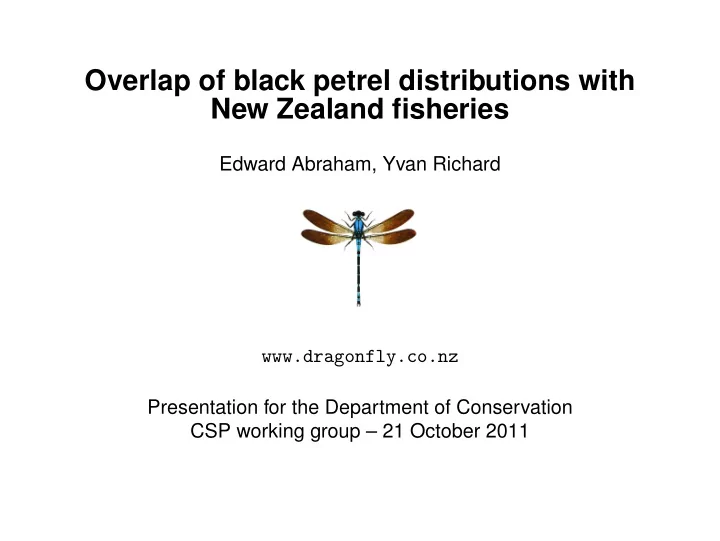

Overlap of black petrel distributions with New Zealand fisheries Edward Abraham, Yvan Richard www.dragonfly.co.nz Presentation for the Department of Conservation CSP working group – 21 October 2011
Defining overlap • Distribution from kernel density of tracking data • Specified as 50%, 75%, and 95% contours • Represents a utilization time: during the survey birds 50% of the time the tracks were within the 50% contour, etc.
Defining overlap • Define a weighting, equivalent to the normalised density • Within the inner contour the weighting is 0.5 divided by the area • Integrates to 1 • Has units of km − 2
Defining overlap • Overlap is the sum of the weighted fishing effort • Take the three areas to be 1, 2, and 5 km 2 • In this case, the overlap is 0 . 5 + 2 × 0 . 25 / 2 + 0 . 2 / 5 = 0 . 79 tows km − 2
Overlap from fisheries data • Use data from other protected species reporting • Define fisheries based on target species • For each fishery calculate the overlap with the distribution from each of the five breeding season distributions • Use fisheries data from 2005–06 to 2009–10 fishing years
Snapper bottom longline Overlap with 2005–06 incubation data 5 hooks 4 -10 5 hooks 3 -10 4 hooks >10 10 10 4 obs hooks 4 -2 × 10 4 obs hooks 4 obs hooks >2 × 10 10 <10 observed captures • Distribution roughly centered on Great Barrier Island • Very little effort • Two observed black petrel captures
Snapper bottom longline Overlap with 2007–08 incubation data 5 hooks 4 -10 5 hooks 3 -10 4 hooks >10 10 10 4 obs hooks 4 -2 × 10 4 obs hooks 4 obs hooks >2 × 10 10 <10 observed captures • Distribution larger in area and offshore • Effort in Hauraki Gulf • No observer data
Snapper bottom longline Overlap with 2008–09 incubation data 5 hooks 4 -10 5 hooks 3 -10 4 hooks >10 10 10 4 obs hooks 4 -2 × 10 4 obs hooks 4 obs hooks >2 × 10 10 <10 observed captures • Distribution area increased again • Hauraki gulf outside the 75% contour • No observer data
Time variation in overlap Bottom longline ( × 10 − 3 hooks km − 2 ) 60 ● 50 ● ● 40 Overlap 30 20 10 ● ● 0 2006 2007 2008 2009 2010 Fishing year • Overlap between incubation 2008—09 survey and a range of fishing years • Only uses effort data during the incubation period (16 November to 31 January)
Fisheries overlap Bottom longline ( × 10 − 3 hooks km − 2 ) Fishery Pre-egg Incubation Chick Annual total Snapper 32.65 42.15 119.48 194.28 Bluenose 5.07 27.52 62.71 95.30 Ling 1.63 17.30 14.67 33.60 Other 1.40 4.43 10.76 16.59 Note that overlap numbers are not comparable between different fishing methods
Fisheries overlap Surface longline ( × 10 − 3 hooks km − 2 ) Fishery Pre-egg Incubation Chick Annual total Bigeye 3.84 7.89 51.04 62.77 Swordfish 0.63 0.48 4.86 5.97 Bluefin 0.02 0.00 2.20 2.22 Albacore 0 0.06 0.59 0.65 Other 0.00 0.12 1.99 2.11 Note that overlap numbers are not comparable between different fishing methods
Fisheries overlap Trawl ( × 10 − 3 hooks km − 2 ) Fishery Pre-egg Incubation Chick Annual total Inshore 0.06 0.13 0.38 0.57 Scampi 0.00 0.02 0.03 0.05 Deepwater 0.00 0.01 0.03 0.04 Mackerel 0.01 0.01 0.01 0.03 Mid-depths 0.00 0.01 0.01 0.02 Flatfish 0.00 0.01 0.01 0.02 Hoki-hake-ling 0.00 0.01 0.00 0.01 SBW 0.00 0.00 0.00 0.00 Squid 0.00 0.00 0.00 0.00 Note that overlap numbers are not comparable between different fishing methods
Comparison with observed captures 2005–06 to 2009–10 Method Fishery Captures Observed effort Rate Bottom longline Snapper 25 1087 0.022 Bluenose 14 340 0.041 Hapuku 7 152 0.046 Surface longline Bigeye 21 327 0.064 Swordfish 1 72 0.013 Trawl Scampi 4 1988 0.201 Inshore 1 2159 0.046 Observed effort in 1000’s of hooks for longline methods, and in tows for trawl fisheries. Rate in observed captures per 1000 hooks, or per 100 tows. Observed captures as used for estimating seabird bycatch, with some imputation of species codes.
Summary • Fisheries with high overlap have observed captures • No clear relationship between observed capture rate and overlap • Considerable variation in distribution between repeated tracking surveys • Useful analysis to carry out as part of the risk assessment purposes
Recommend
More recommend